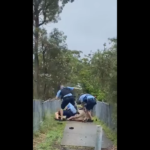The Dangers of Drowsy Driving

The law in Australia is that a person cannot be found guilty of dangerous or reckless driving if they were asleep at the time, as long as they honestly and reasonably believed they would not fall asleep. In other words,
“… where the question is whether a driver who falls asleep at the wheel is guilty of driving in a manner dangerous to the public, the relevant period of driving is that which immediately precedes his falling asleep. Not only must the period be sufficiently contemporaneous with the time of impact… but the driving during the period must be, in a practical sense, the cause of the impact and death. The relevant period cannot be that during which the driver was asleep voluntarily”.
This is known as the ‘Jiminez defence’, and is based upon the idea that a criminal act must be voluntary, and that a person cannot be acting voluntarily if they are asleep.
Some prosecutors claim that the Jiminez defence allows people to defeat driving charges by falsely claiming to have fallen asleep behind the wheel.
Criminal defence lawyers disagree, pointing out that defence counsel must raise some evidence that the defendant was in fact asleep, and was not overly ‘drowsy’ prior to falling asleep, before the onus shifts to the prosecution to prove otherwise – which may be achieved through evidence of the defendant’s manner of driving, state of mind (as expressed during a police interview or on witness stand) and/or the testimony of any eye-witnesses or experts.
Sleep Apnoea
Sleep apnoea is a condition which can cause sufferers to fall asleep without warning. Many are unaware that they have the potentially dangerous condition until formally diagnosed.
The availability of the Jiminez defence to sufferers of sleep apnoea has been labelled a ‘legal loophole’, with victims groups suggesting that sufferers should be required to notify the RMS and have their fitness to drive assessed before being allowed behind the wheel.
The relationship between sleep apnoea and dangerous driving was recently explored in the decision of Adamczuk.
R v Adamczyck [2010] NSWDC 76
It was 3.30pm on a clear day, when 57-year-old Mr Adamczyck started his drive home from work in the Nowra area.
He was cruising along the Pacific Highway when his car began to drift between lanes before hitting a guardrail. The car then returned to the correct position before finally veering directly into the path of Catherine Adams’ car, who tragically died later in hospital.
Mr Adamczyck was subsequently charged with ‘dangerous driving occasioning death’.
Dangerous Driving Occasioning Death
Section 52A(1) of the Crimes Act 1900 (NSW) says that a person is guilty of dangerous driving occasioning death if the prosecution proves beyond reasonable doubt that they were driving:
- under the influence of intoxicating liquor or a drug,
- at a speed dangerous to others, or
- in a manner dangerous to others.
The prosecution must further prove that the conduct caused another person’s death. The maximum penalty is 10 years imprisonment.
The test for driving ‘in a manner dangerous’ was set out in Adamczyck:
“The Crown must prove that the accused’s manner of driving substantially and seriously breached acceptable driving standards and gave rise to a very real potential danger to another person or persons. The question is whether, objectively speaking, the quality of the accused’s driving substantially and seriously departed from acceptable driving standards.”
Back to the Case…
Mr Adamczyck testified that all he could remember about the incident was a loud noise, possibly from colliding with a guardrail, followed by his car heading uncontrollably towards oncoming traffic. He could not recall the events immediately before or afterwards.
He was later formally diagnosed with sleep apnoea, a condition he was previously unaware of. His defence lawyers obtained a report from Associate Professor Wheatley which contained an opinion that:
“As he was unaware of his diagnosis of obstructive sleep apnoea, and had not sought medical assistance for this prior to the accident … He appears to have been largely unaware that his sleepiness was a clinical problem.”
The report further stated that the movement of the vehicle was consistent with Adamczyck having several ‘micro-sleeps’, which supported the conclusion that he was asleep when his car lost control.
Being unaware of his condition, and honestly and reasonably believing it was safe for him to drive, Adamcyck was found not guilty of dangerous driving occasioning death.
Going to court for a traffic offence?
If you are going to court for a traffic offence, call or email Sydney Criminal Lawyers anytime to arrange a free first consultation with an experienced, specialist traffic lawyer who will accurately advise you of your options, the best way forward, and fight for the optimal outcome in your specific situation.






